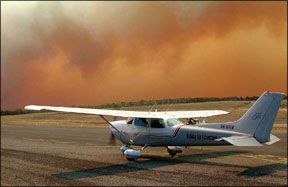Th
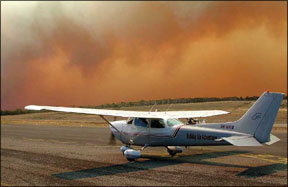
Photo courtesy CASA and Peter Burns
even if the Cessna 172 will never be classified as exciting, some engineers got a lot of things right. It performs almost any mission well, has good stability, control response that is docile enough for the hamfist, low stall speeds and is possessed of a very rugged airframe. We are aware of only two in-flight breakups for the entire series of over 40,000 airplanes.
Model History
The Cessna 172 began production in 1956 with a 145-HP Continental engine. In 1962 engineers hung a 210 HP, six-cylinder Continental on the airframe and began flight testing the combination the next year. It went through certification and was initially sold to the U. S. Air Force as the T-41B in 1967. Known to the FAA and within Cessna as the model R172E, the decision was made to build the civilian Cessna 172 on steroids at Cessnas plant in Reims, France starting in 1968. There it was called the Reims Rocket and as the FR172E through I series, was one of Cessnas hotter sellers.
In the U.S., Cessna planned to replace the Cessna 172 with the Cessna 177 Cardinal in the 1968 model year as part of an overall plan to return all of its single engine airplanes to sleeker cantilever wing designs. (Cessna started manufacturing airplanes in 1927 and did not put a wing strut on a production airplane until 1946.)
It had begun the process with the Cessna 210 in 1967 and was to replace the Cessna 182 with the Cessna 187 in the next year or two. (A cantilever, high wing, two-seat, pusher design was being evaluated to take over for the Model 150. Weight and balance issues later took it out of the running.)
Much as it took years to replace the venerable DC-3, Cessnas attempt to create a replacement for the Skyhawk in the Cardinal did not go as planned. The Cessna 177 had a greater empty weight than the Cessna 172 it was to replace, had a cabin that was larger than the Cessna 182 and carried about 10 gallons more fuel, making it much easier to overload. And overload it pilots did. They then proceeded to complain about its performance, even though in numerous comparison tests a Cessna 177 would slightly outclimb and outrun a Cessna 172 when each was loaded at published gross weight. To top off the problem, the Cardinal was noticeably more responsive in pitch and roll and pilots used to the more sluggish handling of the Cessna 172 were known to overcontrol the Cardinal, particularly on landing, leading to a rash of broken nose wheels. As with poor workers blaming their tools, the Cardinal got an early bad rap in the market from which it only recovered after it was out of production.
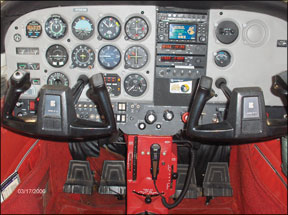
Cessna quickly realized that the Cardinal was not going to do what had been hoped and used many of the thousands of 150 HP Lycoming O-320-E2D engines it had purchased for the Cardinal to replace the 145- HP Continental O-300-D on the Cessna 172, putting the Skyhawk back into production in the latter portion of the 1968 model year.
In 1969, the Cessna 177 got a 180-HP Lycoming O-360, which remained its powerplant through the end of its production run in 1978. We suspect that Cessna did not initially market the R172 series in the U.S. because its performance was very close to the much larger cabin Cessna 177 and it would have had two
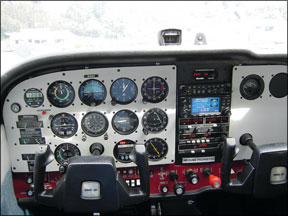
airplanes in the same market niche. That may also be why Cessna didnt build the model 177 in France yet it did build the Cessna 177RG there.
A number of Air Forces throughout the world (T-41B through D) and European civilians were the sole beneficiaries of the Cessna R172 series from 1968 through 1976. By the mid-1970s the handwriting was on the wall for the Cardinal. With all of its compound curves, it was more expensive to build than even the Cessna 182 and sales were dropping steadily. Anticipating the end of production of the Cardinal, Cessna decided to sell the Reims Rocket in the U.S. under the appellation of Hawk XP, with the XP denoting “extra performance.”
For 1977, the R172K in both the U.S. and France mounted a six-cylinder Continental IO-360K with a two-blade constant-speed propeller. This powerplant normally produced 210 HP at 2800 RPM but Cessna derated the engine to 195 HP at 2550 RPM to meet noise requirements. The gross weight was 2550 pounds, 250 more than the Skyhawk for the same year.
For two years or so, the Skyhawk, Hawk XP and Cardinal were sold side-by-side. Average equipped prices for 1977 were: Skyhawk $30,050; Hawk XP $38,680; Cardinal $39,195. The following year, presumably to avoid direct competition between the Cardinal and Hawk XP, the Cardinal was loaded with avionics, a new name (Cardinal Classic) and had its price cranked up to a hefty $50,760 versus $41,050 for the Hawk XP.
Cessna got the marketing and pricing right with the Hawk XP. In the year of introduction, the company built 724 Hawk XPs, versus only 149 Cardinals. In 1978, another 204 XPs roll out the factory doors compared with a lackluster 74 Cardinal Classics. We think the disparity in the second year had at least as much to do with the hefty price increase on the Cardinal as anything else.
Interestingly, the Hawk XP was one of the first of the Cessna line to succumb to the general aviation decline of the 1980s. Production lasted only through 1981, with a total run of 1450 airplanes, over half of which were built during the first year of production. During that time, few changes were made.
The Hawk XP was the beneficiary of the company-wide switch to 28-volt electrical systems, flap speeds were increased, the crankshaft was strengthened (which carried with it an increase in TBO, from a mediocre 1500 hours to a respectable 2000; the later engines were designated IO-360KB), an oil filter was added, as was an improved avionics rack with a cooling fan.
The company didnt abandon the idea of an uprated Skyhawk, however. In 1977, the standard Skyhawk received a 160-HP Lycoming engine that was better able to swallow 100LL avgas. In 1980, Cessna brought out the Cutlass RG, a retractable Skyhawk with a 180-HP Lycoming and constant-speed prop intended to be a trainer for complex aircraft operations.
In 1983, two years after the Hawk XP ended production, the 172Q Cutlass appeared a fixed gear version of the Cutlass RG which lasted for two model years and 390 units. When Cessna restarted production of the 172 in the 1990s, it again produced the 160- and 180-HP versions of the Skyhawk.
Cardinal comparisons
When the Hawk XP was introduced,
The Aviation Consumer did a side-by-side comparison of the new airplane and the Cardinal. We found that the Cardinal was, on the whole, a better airplane. It offered better handling, better visibility, a much larger cabin, less noise, lower maintenance costs and almost identical performance and load-carrying capacity. The more aerodynamic Cardinal was a bit faster on 15 fewer HP, could carry more and could take off and land a bit shorter. On the other side of the balance sheet, the Hawk XP could fly higher and farther.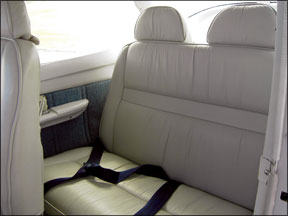
Despite the lack of a clear-cut advantage for the Hawk XP, it trounced the Cardinal in sales in 1977 and 1978. Such is the power of marketing and reputation as we’ll as a much lower price.
At the moment, prices for comparable Cardinals and Hawk XPs are close to one another; average-equipped versions of the two airplanes go for $65,000 and $69,000 respectively. The recent trend has seen the Hawk XP appreciate a bit faster than the Cardinal.
speed
The Skyhawk airframe has much to recommend it, but sleekness is not high on the list. Those struts as we’ll as the needed frontal area for upright seating take a toll in speed. Book cruise speed for the Hawk XP is only 130 knots and owners report real-world cruise speeds of about 125. Considering that the Mooney 231, also equipped with a Continental IO-360 (albeit producing the full 210 HP) flies along at
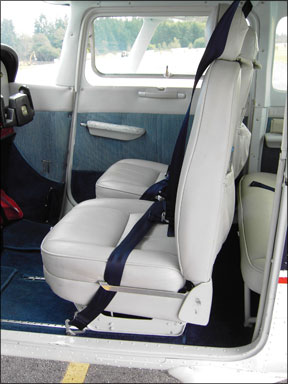
165 or so, the XP is rather lethargic for an airplane with nearly 200 HP.
The impact of a draggy airframe is perhaps more clearly seen by comparing the 195-HP Hawk XP to a standard Skyhawk. Contemporary 172s had 160 HP and the 35 extra horses only generated 8 knots or so more speed in cruise.
Gross-weight climb according to the book is 870 FPM, a tad better than the Cardinal or the Skyhawk of the same vintage and about the same as the Skylane. Gross-weight takeoff performance is virtually identical to the Skyhawk. Of course, the XPs numbers come at a higher gross weight, but 150 pounds of that is taken up by the heavier engine and prop. The real payload difference is only 100 pounds.
Despite the unimpressive book numbers, XP pilots rave about real-world performance. One perhaps optimistic fellow swears he gets 1500 FPM at moderate weights, even in warm weather. In winter, he does better still. We suspect he should have his VSI checked as 1000 FPM at moderate weights is more in accordance with other commentators. “Has near-STOL characteristics,” reports another. This doesnt surprise us. The basic 172 has good short-field performance thanks to its low stall speed and the extra power can only help.
Useful load for a basic-IFR XP runs around 900 to 950 pounds. One owner of a lavishly equipped XP reports 879 pounds. With the standard 49-gallon tanks filled, the cabin load is about 600 to 650 pounds: three people and some luggage. Subtract 100 pounds if the optional 66-gallon tanks are filled.
At max cruise, the XP slurps 11 GPH-plus, but most pilots throttle back to 10 or less. At moderate power, four hours and 450 miles is about as long as youd want to fly one. The optional tanks stretch the range to 650 miles.
Compared to its immediate successor, the Cutlass (same airframe, 180-HP Lycoming), the XP looks bad in terms of payload and range. The Cutlass has the same gross, but weighs 100 pounds less and burns 1.5 GPH less fuel.
Handling
Since the Hawk XP is essentially a Skyhawk, its no surprise that it handles like one…that is, steady, sedate, and not exactly fighter-like, although we did talk to one pilot who taught himself aerobatics in a T-41B, the aforementioned military version of the XP. Roll response is fairly ponderous and pitch control is heavier than the Skyhawk, due to the extra weight of the engine. (The new elevator that appeared in 1981 reduced pitch forces.) Handling characteristics like this are both good and bad, depending on your point of view. They may not set your hair on fire, but snappy handling is exactly what you don’t want in an IFR platform. The stubborn stability of the Skyhawk airframe is one of the biggest reasons it has such a good safety record.
As with all Cessnas, the huge flaps cause some pitch changes and theyre so draggy in the 40-degree position that gross weight go-arounds require some finesse. Flap travel was reduced to 30 degrees in later models to improve handling when slipping with full flaps.
On the ground, the nosewheel steering is rather heavy. And the high-wing design makes the XP susceptible to winds on the ground if the pilot doesnt properly position the ailerons when taxiing. Again, typical Cessna.
In short, the handling is exactly what youd expect from an airplane based on the Skyhawk. Predictable, stable, docile and offering no surprises. These characteristics meet the design mission we’ll and contribute to its historically good safety record.
Accommodations
The interior of the Hawk XP is fairly comfortable. Like the Skyhawk, the panel is relatively tall and the seating position upright. Cessna offered articulated seats with height adjustment, a valuable option, in our opinion, as they fit a wide variety of pilot frames. The seats are subject to the famous Cessna seat-track AD.
Access is easy due to the double doors and getting into the back seats is easier than on low-wing designs. Its easier to step up into a cabin than it is to lower yourself down into a pit. Ventilation on the ground is good thanks to windows that open. There’s adequate head- and legroom for all four seats.
Visibility is the classic tradeoff of high-versus low-wing aircraft. One particular caveat with Cessnas is that the top of the door window is only a few inches above the level of the top of the glareshield. So there’s some obstruction to the side when the seat is raised to improve forward visibility.
The panel is we’ll laid out for airplanes of its vintage, with standard vernier controls and conventional instrument placement. The cockpit gripes applicable to the Hawk XP should come as no surprise to Cessna owners: Royalite panels that yellow and crack, vent tubes that can pop open at high speeds and the less than stellar ARC electronics, although a fair number of the latter year airplanes left the factory without avionics because their owners opted for after-market installations due to the reputation ARC had developed by the end of 1978.
The baggage compartment is of reasonable size, with a fairly large door. It can be accessed in flight. The size of the door is a welcome thing should it be necessary to get out of the airplane through it after a crash.
Engine
The heart of the XPs performance and problems is the six-cylinder Continental IO-360-K and -KB engine. Its expensive to overhaul and has a mediocre reliability record. The engines main problem seems to be that its tough on cylinders. Low compression and/or high oil consumption are not unusual. Not everyone has cylinder problems, of course we had owner reports of 1800-plus hours of trouble-free operation but cylinder cracks, along with piston, ring and valve troubles, seem more common than in similar Lycoming engines. One owner, for example, reported he had to replace two cylinders in the first 600 hours, and then had a cracked piston that allowed most of the oil to leak out. Scans of SDRs show that cylinder cracking is fairly common.
There have also been crankshaft failures. Continental beefed up the crank in 1979, producing the KB engine. It had an improved TBO of 2000 hours. Good thing, too, given the cost of overhaul.
Maintenance
Judging from owner reports, the XP is easy to maintain; not surprising, since it has the same airframe as the familiar Skyhawk. Surprisingly, despite the extra weight up front, we have found no real problems with the nose gear or its attachment at the firewall. Typically, airplanes with heavier engines are more likely to suffer hard-landing damage from pilots slamming the nose down. Still, we recommend a close look at the area.
Unfortunately, most XPs were made during 1977 and 1978, the years in which Cessna let its quality control slip badly as it struggled to meet a huge demand for its airplanes.
By 1979, it had largely corrected the problems for both the airplanes and the ARC radios, although the reputation of the avionics never did recover. Virtually all single-engine Cessnas made at this time had improperly performed paint jobs. Trying to get airplanes out the door as fast as possible, Cessna ignored DuPonts specifications and used a cheap, quick primer under the paint. The result was persistent filiform corrosion that affected hundreds (if not thousands) of aircraft, particularly those based in warm, humid climates. By now, most if not all of these aircraft have been repainted, but a check should be part of the pre-buy inspection.
One advantage of buying a Cessna single is that its very easy to find parts and maintenance expertise. The Hawk XP is no exception. The airframe holds no surprises and its not different enough from the standard Skyhawk to cause any trouble for mechanics.
There are no particularly onerous ongoing ADs on the Hawk XP. Naturally, several of those that apply to the 172 also apply to the XP, but for the most part theyre one-time modifications that should have been done long ago. Recent directives include 2004-19-01, for inspection of upper shoulder harness adjusters; 2002-13-04, inspection of the magneto impulse coupling; 2000-23-21, a one time sampling of the metallurgy of the crankshaft and possible replacement; 2000-06-01, inspection of the fuel strainer assembly; 97-1-13, a Cessna-specific “shotgun” AD that mandates replacement of hoses; 97-26-17, which calls for ultrasonic inspection of the crankshaft and possible replacement if defects are found; and 95-11-8, inspection of the prop blade clamp screws.
Mods, CLub
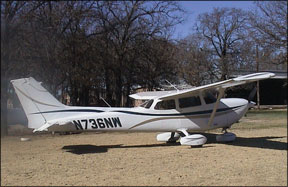
STCs are available to bump the power of the derated IO-360 back up to the full 210 HP (Isham, Inc., www.PlaneTools.com) by increasing the maximum RPM. Hartzell (www.hartzellprop.com) offers one of its three-blade, Scimitar blended airfoil conversion “Top Props” for the Hawk XP which, in our experience with other airplanes, improves rate of climb and reduces vibration without hurting cruise speed
There’s also the usual selection of flap, aileron and elevator gap seals, go-fast fairings and so forth. Its a safe bet that any company that makes mods for the Skyhawk has a version available for the Hawk XP. The owners club to join is the Cessna Pilots Association (www.cessna.org, 805-922-2580) which offers a magazine, insurance discounts and technical help.
Owner Feedback
I was never really a fan of the 172 until I came across this airplane. The engine and prop combo turn the 172 into a truly respectable performer.
Expenses for last year were $1170 for maintenance and annual, $1160 for insurance for a 600-hour private pilot. I flight plan at 65 percent, 115 knots and 9 gallons per hour.
Ritchie Tice
Springtown,Texas
As a 15,000-hour plus airline pilot and having owned a couple of 182s a C177RG and a straight-leg 177, I would like to comment on the 172XP. I enjoy this airplane a lot, with real world cruise speeds of 125 knots on 10 GPH. My useful load is 940 pounds and I have a direct operating cost of $61 an hour for fuel, oil prop and engine reserve.
My insurance this year was $1208 for a $90,000 hull through Avemco. My quotes were as low as $1000, but I was not able to get the hull value I wanted. The XP has a real-world initial rate of climb of 1200 to 1500 FPM depending upon load and my annuals run about $1500, with some minor fixes.
Since I have owned N45GV, I have redone the panel to include a Garmin 340 and GNS430 along with a Shadin altitude alerter and an STEC 30 autopilot with altitude hold. The airplane is far better than the 172SP and with an Isham conversion, that will give you 210 HP; this truly is the budget 182.
Even though my IO-360 has the old K engine, it has 1525 TTSNEW with compressions all above 73/80 and the airplane burns a quart of oil per nine Hobbs hours. I plan to buy a factory IO-360KB when the time comes. The airframe also has 1525 hours and I would not hesitate to buy another one.
Arthur Aaron
Seattle, Washington
I have owned a 1978 R172K for four years and am closing in on 600 hours. The aircraft came from the factory with the float kit, which includes full corrosion proofing, float attach points and some changes to beef up the structure.
Although it has never been on floats, the chromate corrosion treatment has kept the metal interior of the airframe looking like new and adds extra value. This airplane lived in Alaska before my purchase and a previous owner modified the landing gear for extra large tires and a heavy duty nose fork. Although the large tires and lack of wheel pants slow it down a little, it has been a great mod for other than paved field operations.
On the maintenance side, since the airplane is mostly a 172, the airframe has been easy to keep up. I did fight a nose shimmy problem for a couple of years that was finally put to bed with the change to a Lord shimmy damper.
The Lord damper is a fraction of the cost of the Cessna version, doesnt need periodic service and works like a charm. The power systems are more sophisticated than a 172 and hence have cost more to maintain. The engine was replaced at TBO with a factory remanufactured Continental IO-360KB. Although the cost was a little shocking, the engine has run like a top for 400 hours.
Power is limited to 195 HP in the XP, which is far below where the engine operates in other airframes (up to 220 HP in turbo versions), resulting in a robust application. The six-cylinder engine gives the XP very smooth operations and a great throaty sound.
One engine item to keep in mind is that the early models had an IO-360K engine with only a 1500-hour TBO. Later models and airplanes updated with the KB engine have a beefed up case and crank resulting in a 2000-hour TBO. The IO-360 is fuel injected and has a slight tendency for trouble with hot starts. When I have any problems, I just drag out the manual and use the recommended flooded procedure which works every time. Another added expense of the XP configuration is the constant speed prop. Nothing out of the ordinary for a constant speed setup, but definitely more to maintain than fixed pitch.
As to performance, the normal pilot gripes of “I wish it were a little faster, carried a little more and went a little further” apply as always. Speed wise, with my normal loads of one or two people, I cruise at 125 knots and plan for 10.5 gallons per hour. The fuel capacity is 49 gallons so my effective range with a 1-plus hour reserve is about a no-wind 450 miles.
The maximum gross weight is 2550 pounds and empty weight is 1650 pounds, resulting in a useful load of 900 pounds. With full fuel, it works fine for three good-sized passengers and a little baggage. The bigger engine and constant speed prop give great climb performance. With two on board, 1000 feet per minute up to 5000 is not uncommon at standard temperatures.
Hot weather takeoff performance at gross is less exciting, but dramatically better than a stock 172. If you want even better take off performance, a simple STC is available to raise the maximum takeoff HP to 210 HP by increasing the RPM with a recalibrated governor.
The Hawk XP is a great flying, predictable airplane for either $100 hamburgers or IFR traveling missions. I have heard the R172K referred to as both a “172 on steroids” and a “baby Skylane.” Both of these are pretty fair descriptions and you really need to fly one to appreciate its virtues.
Jeff Pernick
Via e-mail

